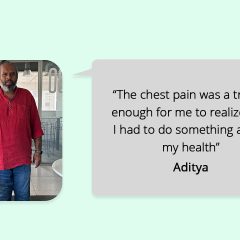 “Psychache” – It is a term coined by experts studying suicide. It refers to the unbearable psychological pain experienced by people, who consider suicide. Contrary to popular belief, suicide is less about attention seeking, manipulation or selfishness and more about an attempt to save oneself from excruciating pain (mostly psychological). People in the throes of suicide ideation, engage in such thinking especially when they are flooded by feelings of guilt, shame, worthlessness, inadequacy, social exclusion, anxiety, humiliation and ending their own life seems like the only way to save themselves from what appears to be inescapable suffering.
“Psychache” – It is a term coined by experts studying suicide. It refers to the unbearable psychological pain experienced by people, who consider suicide. Contrary to popular belief, suicide is less about attention seeking, manipulation or selfishness and more about an attempt to save oneself from excruciating pain (mostly psychological). People in the throes of suicide ideation, engage in such thinking especially when they are flooded by feelings of guilt, shame, worthlessness, inadequacy, social exclusion, anxiety, humiliation and ending their own life seems like the only way to save themselves from what appears to be inescapable suffering.
When feeling this way, the individual’s perception of reality is constricted and sometimes collapsing, thus making it hard for them to access logical thinking and rational consideration of the pros and cons of suicide. This probably answers some of the questions that pop up in our heads about suicide, like – How can people ignore their survival instinct? Why can’t they see that things will get better? What stops them from reaching out for help?
Most people are tempted to argue and attempt to convince a suicidal person that suicide is not a solution to their problems. Unfortunately, the more we argue using cold logic, the more we deny the pain experienced by the person, aggravating the feelings of isolation and hopelessness they experience and thus the argument has the exact opposite effect, almost adding to the person’s conviction that they should go ahead with the suicide.

Some Common Myths About Suicidal Thinking
The key to understanding suicide is to understand suicidal thinking. The following myths and facts might help you save a life!
Myth #1: People who say that they are going to suicide are looking for attention.
Fact: Suicide is an extreme step that a person is driven to by deep feelings of helplessness, hopelessness and desolation. If someone says that they plan to suicide, believe them, and do not dismiss it as attention seeking behavior. Threatening suicide is a way of asking for help. Support them by listening and offering to help. The support may prevent them from taking this step.
Myth #2: All suicidal people have some or the other mental illness.
Fact: Though some people are diagnosed with a mental disorder, concluding that an individual is suicidal because of depression or other mental illnesses, is actually overlooking the real issue. Not all people with mental illnesses attempt suicide and not all who attempt suicide have had a history of mental illness.
Myth #3: The only people who can help a suicidal person are mental health professionals.
Fact: Any person who can listen non-judgmentally and provide support can effectively intervene. Professionals often involve friends and family for interventions.
Myth #4: If a person tells you about their suicidal thinking, you shouldn’t betray their confidence by telling others about it.
Fact: If you become aware that someone is considering suicide, you must inform a family member or friends who care, so that they can provide support. Informing loved ones is an important step in preventing suicides. Knowing that others care for them and that they are valued and wanted, discourages people from taking the extreme step.
Myth #5: If you suspect that a person may be considering suicide, never directly ask them whether they have had suicidal thoughts.
Fact: People worry that asking a person whether they have had suicidal thoughts can plant the idea of suicide in their head. On the contrary, asking to find out whether a person is thinking about suicide may allow the person to share their concerns and worries, and prevent them from deciding to die. It also lets them know that you care and worry about their safety.
Myth #6: Once a person decides to suicide nothing can stop them.
Fact: Most people who consider suicide are unsure about the choice. More than 90% of suicides are preventable. “Should I hang in there for one more day?” is a question that they end up asking themselves often. If one feels supported while feeling suicidal, and gets help in finding therapy or other support services, it can prevent them from taking such a decision now and in the future.
Myth #7: Improvement after a suicidal crisis, is equal to no more suicide risk.
Fact: The weeks and months that follow a suicidal crisis are the most high-risk period because when the person who attempted suicide starts to feel stronger, they feel more capable of taking actions required to carry through the suicidal intention.
In the next part of this blog, we will help you understand suicidal thinking and ways to provide support to those who need it. Keep your loved ones close!
#BeTheForce



